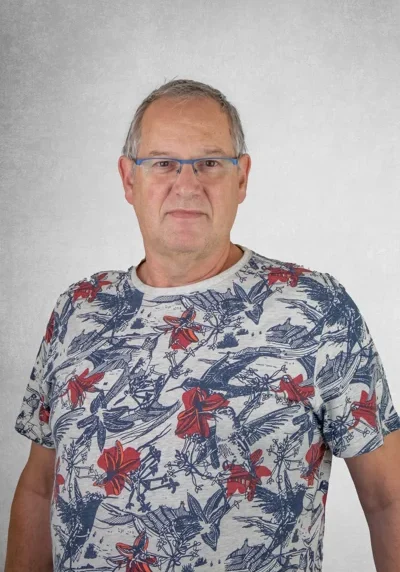Henk den Hartigh
Henk den Hartigh started his career at Schothorst Feed Research in 1983 as a lab analyst, working just twenty hours a week. “I wasn’t only in the lab, I also helped with poultry research. For example, I ‘milked’ roosters for hen insemination,” he says with a laugh. By the late ‘80s, veterinary tasks were added to his role, such as drawing blood and histology. Since the early 90s, he became head of the analytical and zoological lab, and he led the team with great joy until 2022.
Working conditions contribute to job satisfaction
Henk lives in ‘t Harde, between Harderwijk and Zwolle, about a half-hour drive from Schothorst. “In the beginning, the analytical lab work and veterinary lab tasks were separate, but over the years, they have increasingly merged,” he explains. Nowadays, animal technicians also fall under the lab’s responsibilities. “It makes sense that the person collecting the samples also understands what analyses will be done with them.”
Over the years, Henk has witnessed many changes in the lab. “For instance, we moved from the traditional Kjeldahl method for nitrogen analysis to Dumas, and NIRS has replaced many wet-chemical analyses,” he shares. “We now have specialized equipment that makes the work for analysts simpler and more efficient.” Information technology and artificial intelligence, with self-learning algorithms, also play a key role in research today. “But human expertise remains indispensable. A critical eye is needed to spot errors in lab results and implement improvements,” Henk believes.
Two years ago, Henk transitioned from Head of the lab to quality control and occupational health services. He was already conducting audits for Schothorst, Lloyds, and Voederwaarde.nl. “The goal of an audit is always to improve as an organization, not to hold people accountable for small mistakes. Everyone makes mistakes, as long as you learn from them,” he emphasizes.
Henk enjoys the process-oriented work and sees audits as an opportunity to highlight issues and suggest improvements. “Of course, you also need to identify risks and deliberate errors, but it’s always about the shared objective,” he explains.
In his role with the occupational health service, Henk advises internally on working conditions, but the final responsibility lies with management. “No one wants employees to suffer injuries because the work is too physically demanding or someone falls down the stairs,” says Henk. He notes that occupational safety regulations are often viewed as bureaucratic, but he feels that this view is misplaced. “Safety really needs to be in everyone’s mindset. I’d rather you take longer to do a task safely than rush and get hurt.”
Henk acknowledges that it can be difficult to make people see the importance of safety regulations. “Often, you don’t notice the damage until later, when it could have been prevented,” he says. He stresses the importance of good leadership, practical workspaces, and making sure safety goggles and helmets are available. “Even if you’ve been driving a forklift for years, you need a forklift license. Without that license, the entire organization could be in trouble if something goes wrong.”
Inspections and regulations are becoming stricter, especially in terms of working conditions. But according to Henk, proper documentation and compliance with the rules are essential for creating a safe working environment.
